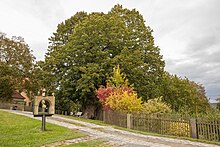Schmorsdorf lime tree
The tree gained historical significance during the Thirty Years' War and was first mentioned in writing around 1630 due to its impressive size.
The lime tree stands at the center of the small village of Schmorsdorf near Maxen, which was originally designed as a loosely arranged circular settlement.
[1] It is situated on a hill in the Osterzgebirge foothills, five kilometers south of Dresden's city boundaries, and rises 305 meters above sea level on a piece of grass with a slight southward slope.
Next to the museum are three old distance columns, known as lapidaries, and a bust of Clara Schumann created by Lungkwitz sculptor Hans Kazzer in 2008.
Overhead power lines and sealed surfaces, as well as driving on the root zone, affect the location of the Linden tree.
[2] The lime tree's impressive size and shape were first mentioned in official records around 1630 during the events of the Thirty Years' War, as passing troops took note of it.
[3][4] It stands along a historically significant road that once served as an important connection to Dresden, frequently used by troops during the Seven Years' War and by Napoleonic soldiers in the early 19th century.
During her time there, Clara Schumann frequently took walks around Maxen, including nighttime excursions to the Schmorsdorfer lime tree.
On 21 January 1884, during a storm, several large branches broke off from the weakened Linden tree, which had been previously affected by the fire.
There is a plaque on a rebuilt building from 1874, commemorating the events of 9 August 1873, when the flames consumed property and belongings, but through God's mercy, the community was spared.
Located south of the Elbe Valley, between Dresden and Saxon Switzerland, near the border of the Ore Mountains, lie the villages of Schmorsdorf and Maxen.
These villages are famous for the Battle of Maxen, a significant event during the Seven Years' War, where Austrian Field Marshal Daun captured Prussian General Fink on 21 September 1759.
However, the tree has rejuvenated through new growth, and it is our hope that this ancient giant will continue to stand tall, captivating the admiration of future generations.
[8] According to the mountain club Über Berg und Tal's logbook, on 7 May 1911, 40 members of the Society for Saxon History hiked from Malter to Ploschwitz via Reinhardtsgrimma and Maxen, via the Schmorsdorf lime tree.
A gravel pad was placed over the root zone to provide better support for the Linden tree and a drainage system was installed.
[4] In 1993, representatives from the forestry office and the Schutzgemeinschaft Deutscher Wald (Protective Association of the German Forest) inspected the lime tree.
Large branches form a dense, foliage-rich crown at a height of four meters, despite the damage incurred at the end of the 19th century.
[14] Dutch forester Jeroen Pater measured a circumference of 10.50 meters in his book Europas Alte Bäume (Europe's Old Trees) published in 1999.
The museum, named after the pianist Clara Schumann, who hiked to the Linden tree multiple times, is always open and free to the public.
[17] The earliest known documentation of the building dates back to 1888 when it was utilized as a fire station, as depicted in a drawing within the Bergblume (Mountain flowers).
It was inaugurated on 27 May 2006, and has an exhibition area of 6.85 square meters, making it the smallest free-standing museum in Saxony, possibly even in Germany.
Furthermore, as part of the museum's offerings, visitors can watch a film titled 700 Years of Maxen, created by Ernst Hirsch in 1955.
This film is screened on a television set located in the attic of the museum building, providing a unique perspective on the local festival.










